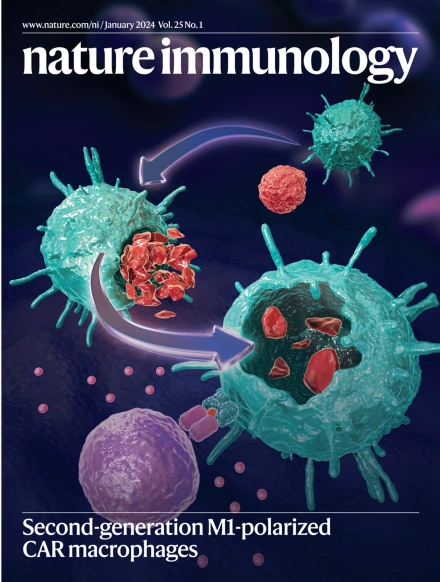人类淋巴组织的时间谱揭示了对病毒挑战的协调防御
IF 27.7
1区 医学
Q1 IMMUNOLOGY
引用次数: 0
摘要
适应性免疫是在淋巴器官中产生的,但这些结构在人类感染时如何保护自己尚不清楚。鼻上皮是病毒进入的主要部位,腺样体鼻相关淋巴组织(NALT)产生早期适应性反应。在本研究中,我们使用鼻咽活检技术,以严重急性呼吸综合征冠状病毒2 (SARS-CoV-2)感染作为自然实验模型,研究了病毒攻击后NALT的纵向免疫反应。在急性感染中,浸润的单核细胞形成上皮下和滤泡周围的屏障,招募中性粒细胞形成细胞外陷阱的中性粒细胞,而组织巨噬细胞在恢复期表达促修复分子,促进组织完整性的恢复。生发中心B细胞表达的抗病毒转录物与决定命运的转录因子呈负相关。在T细胞中,仅组织驻留记忆CD8 T细胞表现出克隆扩增并维持细胞毒性转录程序进入恢复期。总之,我们的研究为人类鼻腔适应性免疫反应如何在面对病毒挑战时产生和维持提供了独特的见解。本文章由计算机程序翻译,如有差异,请以英文原文为准。


Temporal profiling of human lymphoid tissues reveals coordinated defense against viral challenge
Adaptive immunity is generated in lymphoid organs, but how these structures defend themselves during infection in humans is unknown. The nasal epithelium is a major site of viral entry, with adenoid nasal-associated lymphoid tissue (NALT) generating early adaptive responses. In the present study, using a nasopharyngeal biopsy technique, we investigated longitudinal immune responses in NALT after a viral challenge, using severe acute respiratory syndrome coronavirus 2 (SARS-CoV-2) infection as a natural experimental model. In acute infection, infiltrating monocytes formed a subepithelial and perifollicular shield, recruiting neutrophil extracellular trap-forming neutrophils, whereas tissue macrophages expressed pro-repair molecules during convalescence to promote the restoration of tissue integrity. Germinal center B cells expressed antiviral transcripts that inversely correlated with fate-defining transcription factors. Among T cells, tissue-resident memory CD8 T cells alone showed clonal expansion and maintained cytotoxic transcriptional programs into convalescence. Together, our study provides unique insights into how human nasal adaptive immune responses are generated and sustained in the face of viral challenge. Clatworthy and colleagues examine adult nasal lymphoid tissues in response to SARS-CoV-2 infection. Longitudinal profiling reveals changes in barrier tissue to block viral entry beyond the epithelial cell layer and how tissue repair occurred after viral infection.
求助全文
通过发布文献求助,成功后即可免费获取论文全文。
去求助
来源期刊

Nature Immunology
医学-免疫学
CiteScore
40.00
自引率
2.30%
发文量
248
审稿时长
4-8 weeks
期刊介绍:
Nature Immunology is a monthly journal that publishes the highest quality research in all areas of immunology. The editorial decisions are made by a team of full-time professional editors. The journal prioritizes work that provides translational and/or fundamental insight into the workings of the immune system. It covers a wide range of topics including innate immunity and inflammation, development, immune receptors, signaling and apoptosis, antigen presentation, gene regulation and recombination, cellular and systemic immunity, vaccines, immune tolerance, autoimmunity, tumor immunology, and microbial immunopathology. In addition to publishing significant original research, Nature Immunology also includes comments, News and Views, research highlights, matters arising from readers, and reviews of the literature. The journal serves as a major conduit of top-quality information for the immunology community.
 求助内容:
求助内容: 应助结果提醒方式:
应助结果提醒方式:


